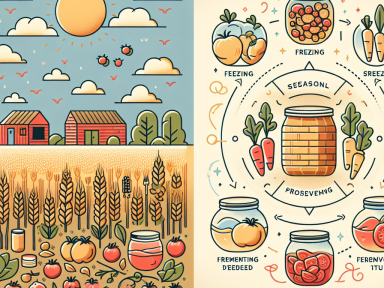The Importance of Seasonal Eating
Before the invention of refrigerators, shipping, and supermarkets, humans depended heavily on seasonal eating. Edibles were eaten fresh when in season and preserved for the colder months. Nowadays, thanks to modern conveniences, we have lost this important skill of eating and living by the seasons. Yet, if we are seeking resilience and greater independence from the food system, it’s time we brought this tradition back.
Why Eat Seasonally?
There are numerous advantages when it comes to seasonal eating. Fresh, local produce is not only more nutritious but also tastes better. It is generally cheaper as it does not involve long-distance shipping or refrigeration costs and supports your local economy. More importantly, it also helps strengthen your connection with the cycle of the seasons and the lands you inhabit.
Getting Started on Seasonal Eating
To begin your journey of seasonal eating, start by learning about your local area — what foods are available and when. Consider visiting farmer’s markets or engaging in agri-community share programs. Make it a habit to focus on foods that are in season, experimenting with new recipes to incorporate them into your meals.
Implementing Food Preservation
Another side of the coin of seasonal eating involves mastering food preservation methods for when your favorite produce is not in season. Food preservation helps you achieve year-round self-reliance, providing you with nutrient-packed foods through all seasons.
Different Methods of Food Preservation
- Canning: This involves the process of sealing food in jars and heating them to kill off harmful bacteria. The food can then be stored in a cool, dark place for months or even years without spoiling.
- Freezing: Freezing can retain the flavor and nutritional qualities of your favorite produce. This is an excellent method to preserve fruits, vegetables, and even animal products like meat and fish.
- Fermenting: This ancient process of food preservation not only increases the shelf-life of foods but adds beneficial probiotics to your diet.
- Drying: Drying is the simplest and the oldest method of food preservation. Sun-drying, air-drying, and dehydrating are all techniques you can use to dry your food and keep it from spoiling.
When practiced well, seasonal eating and food preservation not only secure your food supply but also contribute to a more sustainable way of life. Remember, our ancestors survived, and so can we.
Preparing For Tomorrow, Today
Knowing where your next meal is coming from isn’t a luxury, but indeed a necessity. As whimsical as our current food supply chain might seem, it’s dynamic and susceptible to change. Natural disasters, economic instability, or pandemics can cause disturbances that leave supermarket shelves empty. Are you ready to take control of your food security?
Empower Your Future with Self-reliance
Eating seasonally and preserving food are vital skills to regain control, prepare for the unknown, and secure your health and safety. From a survival standpoint, it’s about being prepared for whatever comes our way. Seasonal eating and food preservation aren’t just about saving money or eating healthier—they’re about surviving and thriving in an unpredictable world.
Ignoring these lessons from the past, these survival techniques which have fed generations, is like ignoring the land underneath your feet. The power to secure your future is in your hands. It’s time we listened to these old whispers of wisdom, for tomorrow’s survival may depend on today’s preparedness.




GIPHY App Key not set. Please check settings